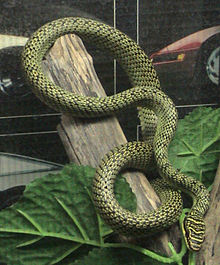Flying snake
| Chrysopelea | |
|---|---|
 |
|
| Ornate flying snake, Chrysopelia ornata | |
| Scientific classification | |
| Kingdom: | Animalia |
| Phylum: | Chordata |
| Class: | Reptilia |
| Order: | Squamata |
| Suborder: | Serpentes |
| Family: | Colubridae |
| Subfamily: | Ahaetuliinae |
| Genus: |
Chrysopelea Boie, 1826 |
| Species | |
Chrysopelea, more commonly known as the flying snake or gliding snake, is a genus that belongs to the family Colubridae. Flying snakes are mildly venomous, though the venom is dangerous only to their small prey. Their range is in Southeast Asia (the mainland (Vietnam, Cambodia, and Laos), Greater and Lesser Sundas, Maluku, and the Philippines), southernmost China, India, and Sri Lanka.
Chrysopelea is also known by its common name "flying snake." It climbs using ridge scales along its belly, pushing against rough bark surface of tree trunks, allowing it to move vertically up a tree. Upon reaching the end of a branch, the snake continues moving until its tail dangles from the end of the branch. It then makes a J-shape bend, leans forward to select the level of inclination it wishes to use to control its glide path, as well as selecting a desired landing area. Once it decides on a destination, it propels itself by thrusting its body up and away from the tree, sucking in its abdomen and flaring out its ribs to turn its body into a "pseudo concave wing", all the while making a continual serpentine motion of lateral undulation parallel to the ground to stabilise its direction in midair in order to land safely.
The combination of forming a C-shape flattening its abdomen and making a motion of lateral undulation in the air makes it possible for the snake to glide in the air, where it also manages to save energy compared to travel on the ground and dodge earth-bound predators. The concave wing that the snake creates in flattening itself, flattens its body to up to twice its width from the back of the head to the anal vent, which is close to the end of the snake's tail, causes the cross section of the snake's body to resemble the cross section of a frisbee or flying disc. When a flying disc spins in the air, the designed cross sectional concavity causes increased air pressure under the centre of the disc, causing lift for the disc to fly. The snake continuously moves in lateral undulation to create the same effect of increased air pressure underneath its arched body to glide. Flying snakes are able to glide better than flying squirrels and other gliding animals, despite the lack of limbs, wings, or any other wing-like projections, gliding through the forest and jungle it inhabits with the distance being as great as 100 m. Their destination is mostly predicted by ballistics; however, they can exercise some in-flight attitude control by "slithering" in the air.
...
Wikipedia
